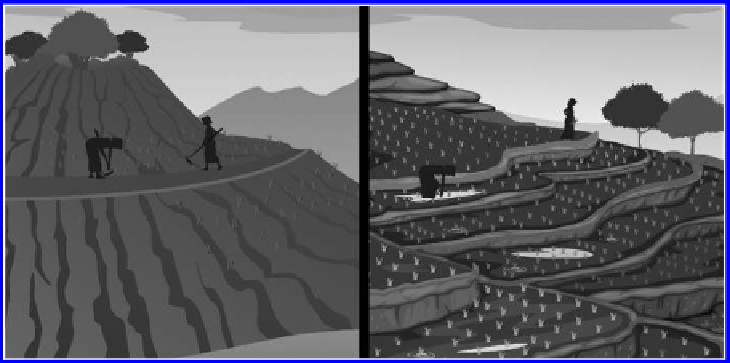Agriculture Reference
In-Depth Information
conservation production system is appropriate for every socioenvironmental situ-
ation. Slope of the land, climatic conditions, availability of resources, availability
of labor, technical skills of the land manager, and a host of institutional factors
influence the type(s) of conservation techniques that are appropriate for specific
situations (
Figure 15.2
)
. The same position has been advanced by El-Swaify (1997)
and Napier et al. (1994).
Anthony et al. (1998) posit that land managers must adopt production systems
that reduce runoff and reduce splash impacts via use of ground cover and the estab-
lishment of barriers to surface water mobility. These authors suggest that soil ero-
sion control approaches can be subsumed under three broad categories that they
refer to as physical measures, vegetative measures, and integrated watershed man-
agement. Physical measures consist of bench terraces, hillside ditches, individual
basins for tree planting, tree terraces, natural terraces composed of bunds that fill
with sediment over time, hexagons composed of roads that provide multiple entry by
machinery, vegetative barriers, grass waterways and barriers, alley cropping, sur-
face drainage systems that divert runoff to reduce water velocity, water-harvesting
systems consisting of small catchments, and holistic conservation systems using the
watershed as the unit of planning.
Anthony et al. (1998) present a number of examples to show how each technique
is implemented. Examples of rice terraces in northern Luzon demonstrate how ter-
races can be an effective means of conserving soil and water resources. Personal
observation in Bali and other islands in the Pacific Ocean by the principal author
of this chapter are indicative of the utility of rice terraces for controlling erosion on
steep slopes (Figure 15.3).
Conservation of water resources via use of runoff farming in the Negev is dis-
cussed by Anthony et al. (1998), as well as tea and coffee plantations on bench
FIGURE 15.3
Terrace farming (right) as a strategy for controlling soil erosion and/or chem-
ical or nutrient runoff. (Illustration by Corey Cockerill and Jamie Henry of ZigNine Design
St ud io.)

